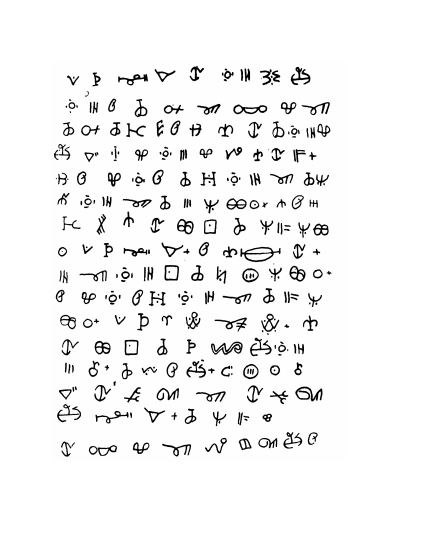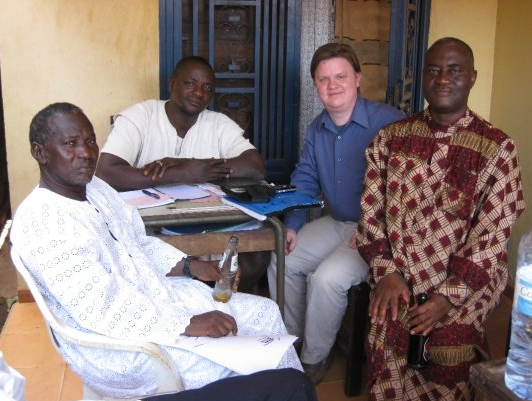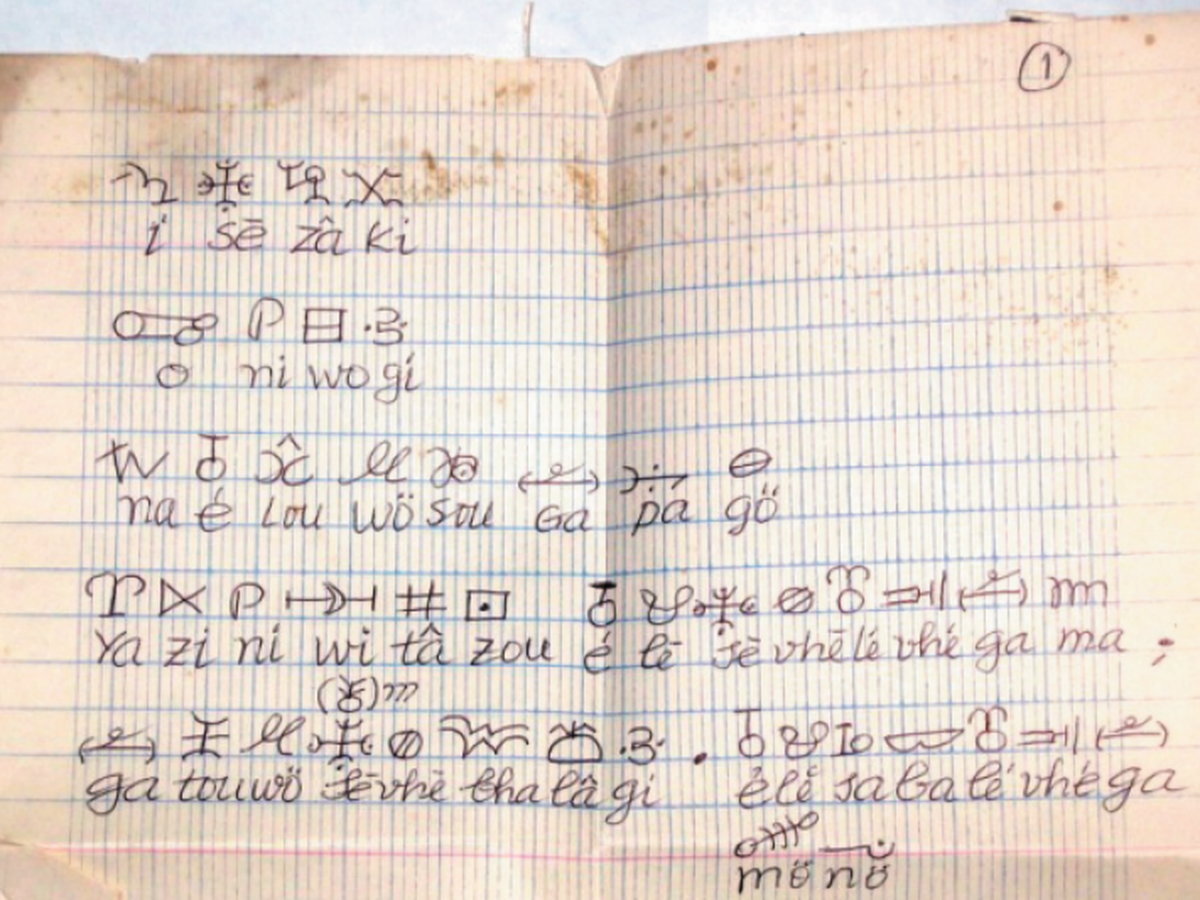In the 1930’s, a man by the name of Widɔ Zoɓo devised a writing system for his mother tongue of Loma, spoken in Liberia and Guinea. He began teaching it in Boneketa, Liberia, and it gained some acceptance on the Firestone plantation where he worked in use for recordkeeping. An elder in Guinea, Vieux Kugbe Onivogui, remembers attending classes in Boneketa and was interviewed in 2009 to offer his reflections on exposure to the script at an early age. It was noted during the 1940’s that the script was in use among soldiers of colonial French West Africa, used in the exchange of letters with soldiers’ families around the garrison of Macenta, Guinea (Joffre, 1945, p. 167).

Fig. 1. Source: Joseph Joffre, “A New West African Alphabet: Used by the Toma, French Guinea and Liberia”. Man, v. 43 (Sep.-Oct., 1943), p. 111.
Another sample of Loma script usage dates from the 1980’s, and is held by the Smithsonian Institution in Washington, DC. Since that time, the work of the late Justin Koivogui and the late Balla Traoré in recording their understanding of the Loma script has provided more helpful documentation. Péma Toupou, Jacques Onivogui, Balla Koevogui, and others have also contributed to current understanding of the structure and extent of use of the script. Together, they have formed an informal group called the Association pour l’Innovation de l’Écriture Loma (AIEL).

Fig. 2. Members of AIEL with Charles Riley in Conakry in 2009.
With a view toward encoding the script into the international Unicode Standard, Charles Riley (Yale University Library and Athinkra, LLC) and Michael Everson (Evertype) have been working with the support of the Script Encoding Initiative (SEI) at the University of California-Berkeley on funding from the National Endowment for the Humanities (NEH). As the project moves forward, it will require more in the way of financial support to ensure that consensus can be arrived at within the community on the most effective way to establish the script’s encoding for efficient communication. Consultation with linguists and community meetings will be needed toward this end. You are warmly invited to contribute to this effort, which will ultimately enable the use of the Loma script through accurate fonts on technological devices.
Bibliography
Everson, Michael. 2010. “Preliminary proposal for encoding the Loma script in the SMP of the UCS”. http://std.dkuug.dk/jtc1/sc2/wg2/docs/n3756.pdf
Joffre, Joseph. 1943. “A New West African Alphabet: Used by the Toma, French Guinea and Liberia”. Man 43, pp. 108-112.
________________. 1945. “Sur un nouvel alphabet ouest-africain: le Toma (frontière franco-libérienne)”. Mémoires de l’IFAN 7, pp. 160-173.
Riley, Charles. 2011. “Recollection of Learning the Loma Script: An Interview with Vieux Kugbe Onivogui”. 3rd International Conference on Mande Languages & Linguistics, CNRS, Villejuif. http://llacan.vjf.cnrs.fr/fichiers/mande2011/ProgrMande2011.pdf
Smithsonian Institution. http://ids.si.edu/ids/deliveryService?id=NMNH-2005-10&max=768

Fig. 1. Source: Joseph Joffre, “A New West African Alphabet: Used by the Toma, French Guinea and Liberia”. Man, v. 43 (Sep.-Oct., 1943), p. 111.
Another sample of Loma script usage dates from the 1980’s, and is held by the Smithsonian Institution in Washington, DC. Since that time, the work of the late Justin Koivogui and the late Balla Traoré in recording their understanding of the Loma script has provided more helpful documentation. Péma Toupou, Jacques Onivogui, Balla Koevogui, and others have also contributed to current understanding of the structure and extent of use of the script. Together, they have formed an informal group called the Association pour l’Innovation de l’Écriture Loma (AIEL).

Fig. 2. Members of AIEL with Charles Riley in Conakry in 2009.
With a view toward encoding the script into the international Unicode Standard, Charles Riley (Yale University Library and Athinkra, LLC) and Michael Everson (Evertype) have been working with the support of the Script Encoding Initiative (SEI) at the University of California-Berkeley on funding from the National Endowment for the Humanities (NEH). As the project moves forward, it will require more in the way of financial support to ensure that consensus can be arrived at within the community on the most effective way to establish the script’s encoding for efficient communication. Consultation with linguists and community meetings will be needed toward this end. You are warmly invited to contribute to this effort, which will ultimately enable the use of the Loma script through accurate fonts on technological devices.
Bibliography
Everson, Michael. 2010. “Preliminary proposal for encoding the Loma script in the SMP of the UCS”. http://std.dkuug.dk/jtc1/sc2/wg2/docs/n3756.pdf
Joffre, Joseph. 1943. “A New West African Alphabet: Used by the Toma, French Guinea and Liberia”. Man 43, pp. 108-112.
________________. 1945. “Sur un nouvel alphabet ouest-africain: le Toma (frontière franco-libérienne)”. Mémoires de l’IFAN 7, pp. 160-173.
Riley, Charles. 2011. “Recollection of Learning the Loma Script: An Interview with Vieux Kugbe Onivogui”. 3rd International Conference on Mande Languages & Linguistics, CNRS, Villejuif. http://llacan.vjf.cnrs.fr/fichiers/mande2011/ProgrMande2011.pdf
Smithsonian Institution. http://ids.si.edu/ids/deliveryService?id=NMNH-2005-10&max=768


